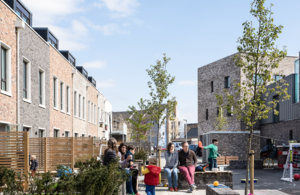A range of measures were launched in July, designed to improve communities’ infrastructure, champion neighbourhood design and support walking and cycling, as part of the government's Building Beautiful Places plan. The plan means that high quality design will be paramount, with local communities placed at the heart of decision-making - allowing them to help shape their towns and cities.
The National Planning Policy Framework (NPPF) is being amended so that the Building Beautiful Places plan will mean residents and planners will find it easier to embrace aesthetically considered, practical design; and reject unattractive, unsustainable or poor quality planning projects.
The changes set an expectation that all councils should develop a local design code - an illustrated design guide that sets the standard for a local area - with input from local people.
The process, outlined in the NMDC, demonstrates how and when local communities can be involved in developing a design code, using digital tools and social media, as well as face-to-face workshops, roundtables and exhibitions.
With an increasingly digitised planning system, local people will also be able to better navigate and access the planning process with online map-based local plans – allowing people to visualise local plans for development and participate more fully in the planning system. Two new web apps recently launched to help homeowners improve and extend their homes.
At a Building Beautiful Places event on July 20, Housing Secretary Robert Jenrick announced a range of measures that, taken together, aims to alter the planning industry in a way that
enshrines quality and sustainability in the heart of local decision-making across the country from city centres to rural villages.
The government announced:
- The National Model Design Code - a toolkit to enable every council and community to create their own local design requirement. Guidance is provided across all aspects of new development including tree-lined streets, sustainable drainage and design to support walking and cycling.
- Updated planning framework published which will place greater emphasis on beauty, place-making, the environment, sustainable development and underlines the importance of local design codes.
- The Office for Place which aims to enhance design standards, testing and piloting the National Model Design Code with more than 20 local councils and communities.
- The Advisory Board, made up of industry experts and chaired by Nicholas Boys Smith, which will advise on the work of the Office for Place and options for a potential independent body.
Greater emphasis will be placed on quality and design in the planning system. Local communities will be involved in how they want new developments to look, with a much greater emphasis on environmental sustainability.
The changes to the National Planning Policy Framework set an expectation that good quality design should be approved, while poor quality should be rejected and includes an environmental commitment to ensure that all streets are lined with trees.
These measures mean the word “beauty” will be specifically included in planning rules for the first time since the system was created in 1947.
Housing Secretary Robert Jenrick said:
I have set out the Government’s vision for a planning system that make beautiful, sustainable and life-enhancing design a necessity, rather than a luxury.
Our revised National Planning Policy Framework will ensure that communities are more meaningfully engaged in how new development happens, that local authorities are given greater confidence in turning down schemes which do not meet locally set standards.
This is about putting communities – not developers – in the driving seat to ensure good quality design is the norm, and the return to a sense of stewardship – to building greener, enduringly popular homes and places that stand the test of time in every sense.
Nicholas Boys Smith, Chair of the Advisory Board for the Office for Place, said:
I am delighted to be Chairing the Advisory Board of the Office for Place. Britain has created and is creating some of the best developments in the world. But the quality achieved remains stubbornly inconsistent. We must do better, more often for the benefit of communities, to contribute to the economic success of our towns and cities and to look after our planet.
Our vision is to help families, neighbourhoods, councils, landowners, housebuilders and developers more easily create places in which our communities can prosper. The Office for Place aims to encourage the British design and development industries to be the best ‘place-makers’ in the world aided by improving data on the discoverable links between place with happiness, health, popularity and sustainability.


